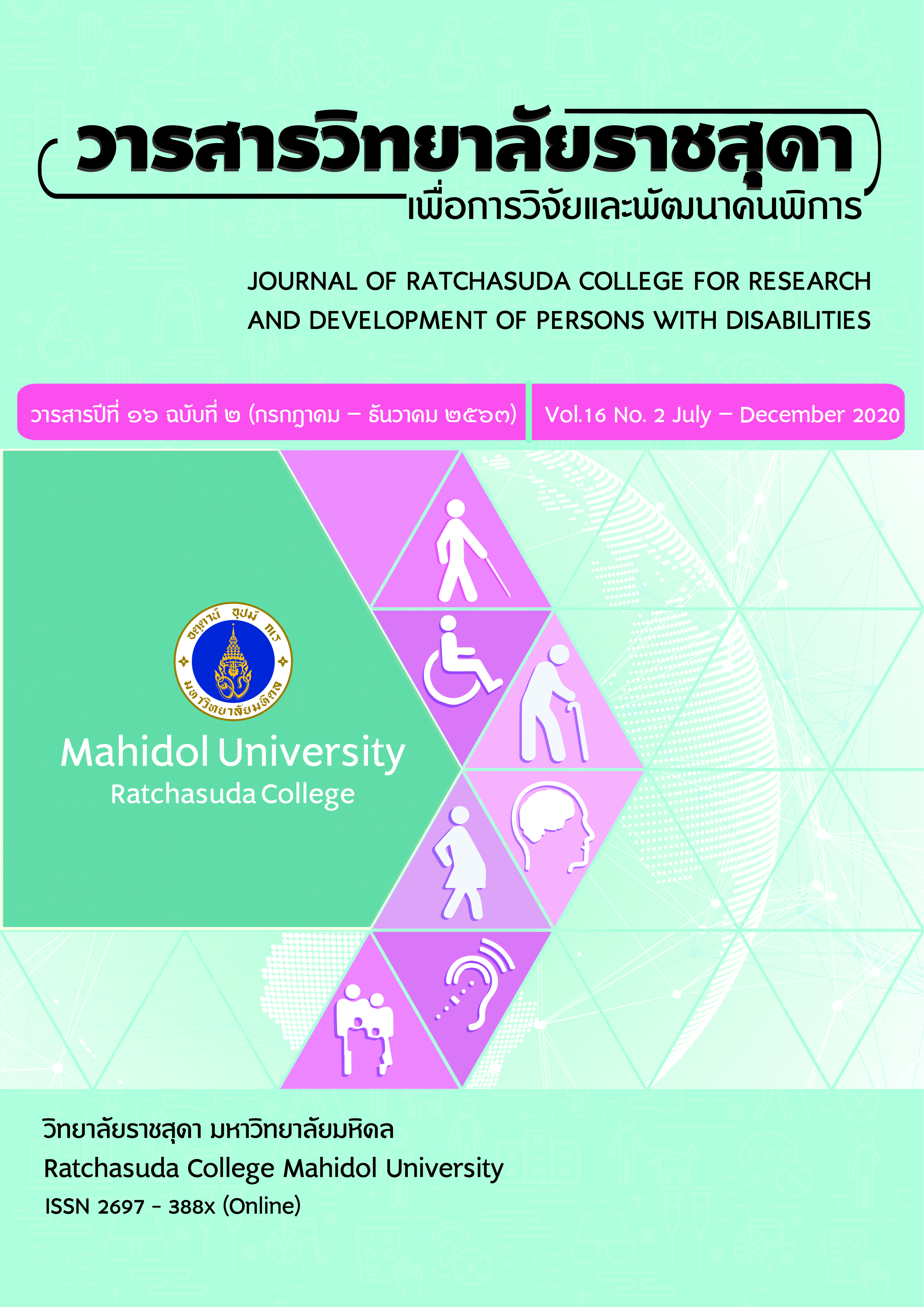Equality in Educational Law for Persons with Disabilities: Thailand and United States
Keywords:
Education Law, Equality, DisabilitiesAbstract
Nowadays, there is a regulation to support equality of human rights, which there must not have discrimination, either for causes of disability or physical causes. Meanwhile, education has been considered to be a cause of social equality and tool for developing country. However, if educational context is not supported for persons with disabilities, the learners will not be able to access educational system and they will not have opportunity for studying. This article is documentary research from the academic articles, the related literatures and the judgment create additional legal knowledge elements about the ways to develop education support for people with disabilities to promote social equality. At the same time, legal principle from USA is compared with Thai’s legal principle which can be seen about better opportunity to support for persons with disabilities in Thailand. The reason is that, USA has been considered as the first country that has regulated to support persons with disabilities, priority on educational support for persons with disabilities, and legal measures to support and also to improve education to be potential for persons with disabilities.Thailand should have multidisciplinary specialists to design the particular curriculum for persons with disabilities and to promote technological devices and facilities for developing quality of education to be effective
Downloads
References
Bickenbach, J. (1993). Physical disability and social policy. Toronto and London: University of Toronto Press.
Boorse, C. (2010). “Disability and medical theory.” in Philosophical Reflections on Disability, D. C. Ralston and J. Ho (eds.), Dordrecht: Springer, 55–90.
Child Protection Act, B.E. 2546. (2003). Government Gazette, 120(95A), 1-12.
Constitution of the Kingdom of Thailand, B.E. 2560. (2019). Royal Thai Government Gazette. Retrieved on 20 May 2020. from https://www.krisdika.go.th/th/law?lawId=1
De Baets, A. (2009). The impact of the universal declaration of human rights on the study of history. History and Theory, 48(1), 20-43.
Department of International Organizations Ministry of Foreign Affairs. (2018). UN Sanctions. Retrieved 25 February 2018 from http://www.mfa.go.th/thai_inter_org/contents/files/policy-20180622-160201-419708.pdf.
Department of International Organizations Ministry of Foreign Affairs. (2015). International covenant on economic, social and cultural rights. Retrieved from http://humanrights.mfa.go.th/upload/pdf/icescrt.pdf.
Education Provision for Persons with Disabilities Act B.E. 2551. (2008). Government Gazette, 125(28A), 1-13.
Education Provision for Persons with Disabilities Act B.E. 2551. (2008). Royal Thai Government Gazette. Retrieved on 21 May 2020. Retrieved from https://www.krisdika.go.th/librarian/get?sysid=686515&ext=htm.
Edwards, C., & Imrie, R. (2003). Disability and bodies as bearers of value. Sociology, 37(2), 239-256.
Empowerment Of Persons With Disabilities Act, B.E. 2550. (2007). Government Gazette,124(61), 1-18.
Florian, L. (2008). Inclusion : Special or inclusive education : Future trends. British Journal of Special Education, 35(4), 202-208.
Gradia, K. (2010). Convention on the rights of the child : The united states lags behind. Retrieved from https://www.humanium.org/en/usa-and-crc/
Gylfason, T., & Zoega, G. (2003). Education, social equality and economic growth : A view of the landscape. CESifo Economic Studies, 49(4), 557-579.
Kabeer, N., & Natali, L. (2013). Gender equality and economic growth : Is there a win win?. IDS Working Papers, 2013(417), 1-58.
La Salle, T. P., Roach, A. T., & McGrath, D. (2013). The Relationship of IEP Quality to Curricular Access and Academic Achievement for Students with Disabilities. International journal of special education, 28(1), 135-144.
Marmor, A. (2005). Authority, equality and democracy. Ratio Juris, 18(3), 315-345.
Miles, S., & Singal, N. (2010). The education for all and inclusive education debate : Conflict, contradiction or opportunity?. International journal of inclusive education, 14(1), 1-15.
Morrissey, F. (2012). The united nations convention on the rights of persons with disabilities : A new approach to decision-making in mental health law. European Journal of Health Law, 19(5), 423-440.
National Statistical Office. (2019). Disability survey B.E. 2560. Retrieved February 24, 2020 from http://www.nso.go.th/sites/2014/Pages/Press.Release/2562/N29-03-62-1.aspx.
Nuchpongsai, P., & Srisurakul, T.S. (2019). Administration and support services for students with disabilities in the colleges under the office of vocational education commission. Journal of Education Naresuan University, 21(3), 167-179
Office of Special Education and Rehabilitative Services. (2000). A Guide to the Individualized Education Program. Retrieved 25 February 2018. Retried from https://www2.ed.gov/parents/needs/speced/iepguide/iepguide.pdf
Rains, R. E. (1999). Cedar Rapids Community School District v. Garret F. scope of ‘related services’ under American special education law.11(2), 121-126
Saisunthorn, C. (2012). International law. Bangkok Thailand: Winyuchon.
Special Education Bureau. (2020) Report the total number of with learning disabilities.Retrieved February 24, 2020, from http://specialbasic.specialset.bopp.go.th/specialbasic/download/student
The World Bank. (2020) Education. Retrieved February 10, 2020, from https://www.world bank.org/en/topic/education/overview
U.S. Department of Education. (1997) Individuals with disabilities education act. Retrieved February 10, 2020, from https://sites.ed.gov/idea/
United Nation. (2018). Universal declaration of human. Retrieved February 13, 2020, from Rights https://www.un.org/en/universal-declaration-human-rights/
Valentino, A. (2006). The individuals with disabilities education Improvement act : Changing what constitutes an appropriate education. JL & Health, 20, 139.
Weller, K. (2016). What is the universal declaration of human rights?. Retrieved February 16, 2020, from https://eachother.org.uk/universal-declaration-human-rights/
World Health Organization. (2011). Summary : World report on disability. Geneva: World Health Organization. Retrieved February 10, 2020, from https://www.who.int/ disabilities/world_report/2011/report/en
Yell, M. L., & Bateman, D. F. (2017). Endrew F. v. Douglas County School District (2017) FAPE and the US Supreme Court. TEACHING Exceptional Children, 50(1), 7-15.
Yell, M. L., Katiyannis, A., & Hazelkorn, M. (2007). Reflections on the 25th anniversary of the US Supreme Court’s decision in Board of Education v. Rowley. Children, 39(9).
Zorek, J., & Raehl, C. (2013). Interprofessional education accreditation standards in the USA: a comparative analysis. Journal of Interprofessional Care, 27(2), 123-130.
Downloads
Published
How to Cite
Issue
Section
License
บทความที่ได้รับการตีพิมพ์เป็นลิขสิทธิ์ของวารสารสถาบันราชสุดาเพื่อการวิจัยและพัฒนาคนพิการ






